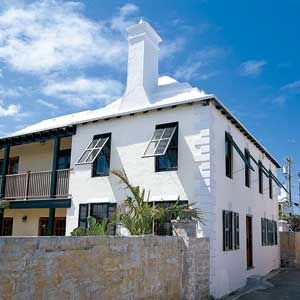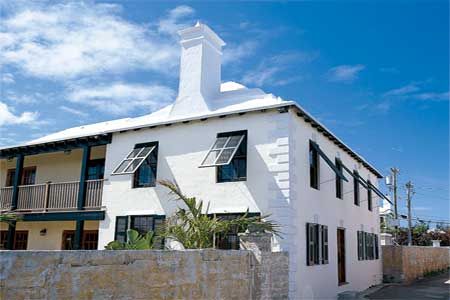
From the archives: The Bermuda House, 2004
The neglected Georgian known as Harbour View is usually described as being “circa 1805,” which means that no one really knows when it was built. It’s also been expanded, reconfigured, and updated so many times over the years that restoring it to its “original” condition would seem to be quite out of the question. So how does an architect charged with such a project create a home that satisfies historians and clients alike?
If you’re Colin Campbell, you do your homework, gather your evidence, and forge ahead. “The house was listed as being built in roughly 1805, but we couldn’t be sure,” he says. So he paid a visit to the national archives, where he found watercolors from 1828 by Bermuda landscape artist Thomas Driver. Among the views of St. George’s were a few that showed Harbour View and Hillcrest (now Aunt Nea’s). “So both buildings were there in 1828, with hunter green shutters, and an ochre wash on the walls,” Colin says. “Harbour View had a chimney, which was good to see — I’d been concerned it had been a later addition.”
With that little information to go on, Colin knew what he had to do. “The exterior of the building was intact, and it will remain so; it remains true to the street,” he says. “But it really had to be gutted. The woodwork was completely infested with termites. There were some remnant pieces to take some value from, but nothing was worth saving in its entirety. And there was no way we could take any kind of historical analysis — the house had been largely rebuilt, with modern improvements, over two hundred years. The historical ranks were concerned about authenticity, but there had been so many changes it was impossible to remain completely true.”
At first, the architect was inclined to leave the central staircase in position and work a floor plan around that. Homeowners Delaey Robinson and Andrea Dismont lobbied for an even more radical change—take out the staircase, and start from a truly blank slate. Colin resisted, since he was partial to the cozy room with fireplace behind the stairs. “That room was too small, just useless,” says Delaey. Moving the staircase to the side of the house would allow for larger rooms where the family wanted them. In the end, the staircase was history and the new floor plan began to evolve.
The first order of business was finding new homes, or at least temporary resting places, for the years’ worth of accumulated “stuff” stored in the house. Then began the real demolition — removing the staircase, laying out the new floor plan, and deciding what pieces of the old house could be salvaged. Surprisingly, the main structure of the house was generally solid.
“Bermuda cedar is very rich in cedrine oil, a natural chemical that keeps bugs away,” says Colin. “It’s even used as a constituent in mothballs. Some bark had been eaten, but the redwood was as fresh as the day it was cut. And all the stone was in good shape.” Some of the later additions had not held up so well. “By the time we pulled away the balcony, it almost fell apart on us!”
On an island, it’s wise (and frugal) to recycle as much material as possible, so whatever could be saved from the old house will be restored for use in the new. The woodwork around the windows may have been shot, but the wood sashes themselves and the glass within were eminently salvageable. So instead of ordering a few dozen new windows shipped in, Delaey is putting in his sweat equity on this project by stripping decades of old paint off the sashes.
“I’m stripping the windows with this wonderful goo!” Delaey exclaims. (This Old House fans will remember that we used the same product, RemovAll, in Winchester.) “It’s impressive stuff for one window, but it will get monotonous on thirty of them. The window sashes are old — at the very least tens of years old — and some of the glass is over a hundred years old, so it’s all worth recycling.”
More than halfway through the project now, the pace of the work is accelerating. The new wall extending the main house to the guest quarters has been erected, and the slab has been poured for the new great room. The floor where the old stairwell was has been replaced. A landscape designer is hard at work creating plans for two gardens, once of which will include a lap pool and spa. Delaey describes the past couple of weeks as “frantic,” and he assumes things will only get crazier as the end of the project looms.
“You know how there are places where they line the road with stripes to make you feel like you’re going faster, so you’ll slow down?” he says. “That’s what this is like, and it will accelerate. People who are following on the Web are really lucky — they’re way ahead of everyone, they can see what’s going on now!”
Delaey says he wishes more people could see what it’s really like to be a This Old House project, to the point where he’s offering a special rate at Aunt Nea’s Inn for TOH fans who want to get a look at the job up close. (Contact Aunt Nea’s for details.) The work is expected to end by mid-March, and the family is looking forward to getting their life back. “Norm is going to carve the mantelpiece in the dining room, so we’ll always have This Old House in our house,” says Delaey. We appreciate that, but we know he’ll be pretty happy when he has us only in the mantel, and not actually in his house.

